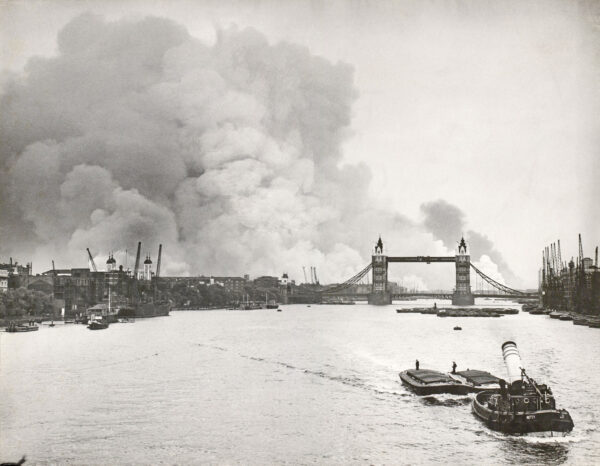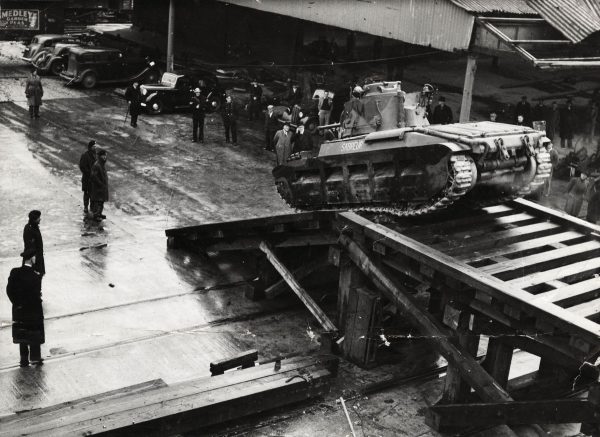On the eve of the 75th anniversary of VE Day, the Museum of London Docklands has released some photos from its online collection that show the devastating impact of WW2 on the area.
During World War II, the docks and riverside factories played a significant role in the war. However, these industrial capabilities meant it also bore the brunt of enemy attack.
London’s docks were the main target, with over 25,000 German bombs falling on the Docklands over the course of the war. By the end of World War II, the damage to the East End left much of the area in ruins. Tens of thousands of homes were uninhabitable, businesses were destroyed, and a third of the Port of London’s docks were decimated with West India Docks and St Katherine Docks suffering most of the damage.

Superintendent’s Office, Royal Albert Dock, October 1938. Port of London Authority (PLA) buildings were reinforced with sandbags so they could be used as air-raid shelters. Photography: John H. Avery & Co © PLA Collection / Museum of London

The Prime Minister and Mrs Churchill, with the Flag Officer, London, and J Douglas Ritchie (on left), touring London’s dock in Sept 1940, seen with a group of auxiliary firemen © PLA Collection / Museum of London

“St Katharine Dock after air raid, September 1940. The damage occurred on Saturday 7 September 1940, the first attack on Docklands. The photographs were taken later as a technical record.” Photography: John H. Avery & Co © PLA Collection / Museum of London

River Emergency Services’ volunteers carrying bandages, and blankets and taking a break from their civil defence duties to pose for this photograph. © PLA Collection / Museum of London

Bomb damage to Albion Public House (built 1878). Corner of Burr Street and St Katharine Way © PLA Collection / Museum of London

Bomb damage to London Dock. Shed, formerly Guiness’s on west side of eastern dock © PLA Collection / Museum of London

Royal Docks air raid precautions. Completed concrete shelter covered with earth. © PLA Collection / Museum of London

Bomb damage to London Dock. Milk Yard Boundary Wall. South side of Shadwell Old Basin © PLA Collection / Museum of London

West India Dock WWII concrete air raid shelter showing precast units being placed in position by crane. © PLA Collection / Museum of London

Damage caused by a V1 rocket which hit Royal Victoria Dock in 1944. © PLA Collection / Museum of London

Air raid damage to Royal Albert Dock, Empire Mills, G Rank Ltd, burnt out store building. © PLA Collection / Museum of London

WWII Air raid damage to Royal Albert Dock no.33 shed, SW corner, with bomb damage on quay. © PLA Collection / Museum of London











Fascinating to see the photos. People were so resilient then, they got back up, dusted themselves off and got back on with it. Despite the Nazi’s best efforts to destroy Britain’s infrastructure and morale they failed miserably.
And now people are whingeing about having to stay indoors and not get together with family. Back then you could be separated for many years. How times have changed!✌
Great images. What’s really amazing, seeing the shot of St Katherine’s Dock, is that they deliberately burnt one building for the making of the Blitz sequence in the film Battle of Britain – and blew up a genuine WW2 hangar ar RAF Duxford too!
The photo of a tank arriving at the docks in 1944 prior to use on D-Day seems unlikely. It looks like a Matilda Mk 2, which wasn’t used in Europe or North Africa after 1942. If it really is 1944, then it might be in transit to Australia, who used them in the Pacific theatre – https://en.wikipedia.org/wiki/Matilda_II. If earlier, it might be on it’s way to France with the BEF in 1939/40 or North Africa.
It strikes me as remarkable that anyone should have named a British WW2 tank ‘Matilda’. It’s not exactly a scary name, is it?
Many thanks for those striking pictures. I was in London in 1944, but since I’d only just been born I don’t recall much about the bombing. In 1950 we moved to Bristol, which was still pretty much flattened in the centre. It’s remarkable that so much damage had so little effect on the British war effort – many, many families must have been struggling for – what? – decades afterwards.
An interesting and impressive photo collection. Glad that the Museum of London Docklands decided to release these images to the public